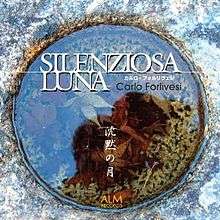Silenziosa Luna
Silenziosa Luna (Japanese: 沈黙の月, Hepburn: Chinmoku no Tsuki) is an album by the Italian composer Carlo Forlivesi. It was released in 2008 by ALM Records.
| Silenziosa Luna | |
|---|---|
 | |
| Studio album by | |
| Released | November 2008 |
| Recorded | 16 June 2008 at Chichibu Muse Park Music Hall, Saitama, Japan (tracks 1, 3–7, 9–12) |
| Genre | Contemporary classical music |
| Length | 67:05 |
| Label | ALM Records (Tokyo) |
| Producer | Yukio Kojima |
"Silenziosa luna" is a quotation from Giacomo Leopardi's poem Canto notturno di un pastore errante dell'Asia.
Description
The album includes works written by Forlivesi between 1999 and 2008. Its 28-page booklet reflects the artistic and cultural concerns of the team about this recording. The linear notes provide information about the musicians and lyrics, and give details on the extent of each musical work, placing them in cultural and creative contexts. They were written in Italian originally and directly translated into Japanese and English, respectively by Japanese musicologist Mariko Kanemitsu and British composer/poet Jeremy Drake. Japanese jiuta-mai dancer Sayuri Uno, American academic Laura Hein (Northwestern University) and Italian philosopher Marco Forlivesi (University of Padua) also made a significant contribution to this process.
The recording gathers accomplished masters and new-generation virtuosos, while the instrumental techniques developed on purpose for these works are likely to be among the most demanding ever written for these instruments. The recording technology employed (24bit/96kHz) brings forth clarity of sound and dynamics, delicacy and a high dynamic range, with a main focus on timbre, textures and transparency.
The artistic photograph reproduced on the album cover is a shot taken by Carlo Forlivesi and Sayuri Uno in "Shisendō", a historic spot in Kyoto; it represents a round-shaped Tsukubai enhanced by natural shadows and reflections. In spite of the apparent complexity of the layers it is a non-processed image. The disc fits the same round-shaped Tsukubai picture finely emulated with sprinkled silver and gold colors, and bears a strong resemblance to maki-e making.
Performers
- Yukio Tanaka voice and biwa
- Kumiko Shuto voice and biwa
- Yosuke Irie shakuhachi
- Ayako Shigenari 13-string koto and 20-string koto
- Norio Sato guitar
Track listing
- 1. Boethius [8:27] biwa
- 2. Japanese Window – Sesshu's Landscape 1495 [9:37] electronic music
- 3. Audivi Vocem [2:10] shakuhachi, 20-string koto and guitar
- 4–7. Nuove Musiche per Biwa [14:35] two biwas
- 8. Through the Looking-Glass [3:36] electronic music
- 9. Ugetsu [5:10] shakuhachi and guitar
- 10–12. En la Soledat i el Silenci [7:31] 13-string koto and guitar
- 13–15. Requiem [14:59] electronic music
Credits
- Director: Yukio Kojima, Carlo Forlivesi
- Recording engineer & tape editor: Yukio Kojima
- Assistant engineer: Miho Fujimoto
- Notes: Carlo Forlivesi
- Translation: Jeremy Drake (English), Mariko Kanemitsu (Japanese), Sayuri Uno (Japanese)
- Design: Natsue Yamanaka
- Booklet editing: Tomomi Kato
External links
- ALM Records (in Japanese and English)
- Kotenha (in Japanese)
- Amazon (in Japanese and English)
- HMV (in Japanese and English)